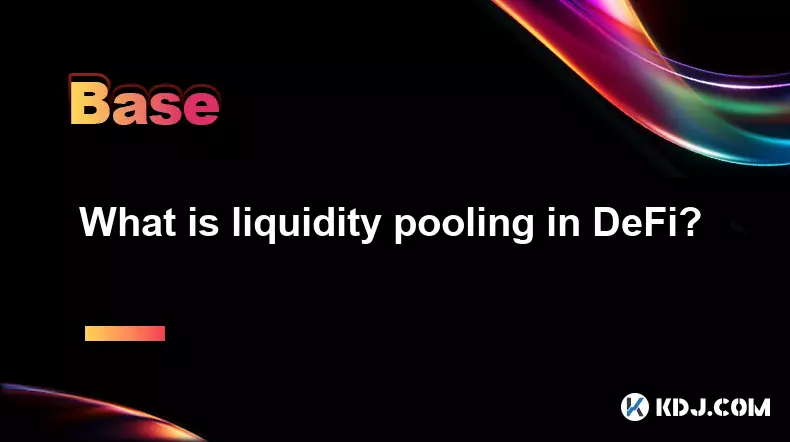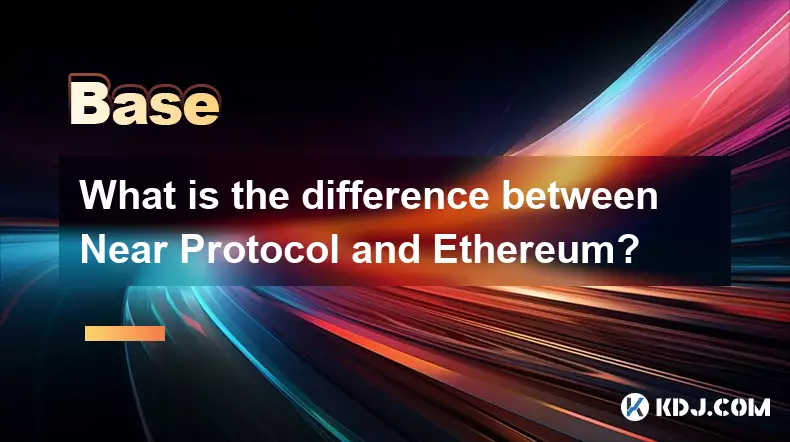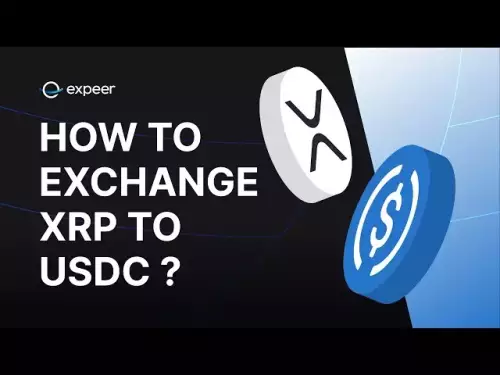-
 bitcoin
bitcoin $112715.707551 USD
-1.71% -
 ethereum
ethereum $4101.475385 USD
-3.01% -
 tether
tether $1.000644 USD
-0.02% -
 bnb
bnb $1207.619465 USD
-6.77% -
 xrp
xrp $2.501451 USD
-3.98% -
 solana
solana $202.947124 USD
-3.32% -
 usd-coin
usd-coin $1.000295 USD
0.04% -
 dogecoin
dogecoin $0.203884 USD
-4.47% -
 tron
tron $0.317154 USD
-1.72% -
 cardano
cardano $0.695009 USD
-4.43% -
 hyperliquid
hyperliquid $38.853961 USD
-8.23% -
 chainlink
chainlink $18.988674 USD
-4.64% -
 ethena-usde
ethena-usde $1.000233 USD
-0.03% -
 stellar
stellar $0.337050 USD
-3.63% -
 bitcoin-cash
bitcoin-cash $536.861728 USD
-1.28%
What is liquidity pooling in DeFi?
Liquidity pooling in DeFi allows users to earn fees by depositing assets into shared pools, but exposes them to risks like impermanent loss and smart contract vulnerabilities.
Oct 15, 2025 at 01:37 am

Liquidity Pooling Explained in Decentralized Finance
1. Liquidity pooling refers to the mechanism where users contribute their cryptocurrency assets into a shared pool on a decentralized exchange (DEX) or DeFi protocol. These pooled funds enable seamless trading, borrowing, or lending without relying on traditional market makers. By depositing paired tokens—such as ETH/USDC—into a smart contract, participants collectively provide the capital needed for transactions.
2. In return for supplying assets, users receive liquidity provider (LP) tokens representing their share of the pool. These tokens can be redeemed later for the original deposited funds plus any accrued fees. Every trade executed against the pool generates a small fee, typically between 0.01% to 1%, which is distributed proportionally among liquidity providers based on their contribution.
3. Automated Market Makers (AMMs) rely heavily on liquidity pools to function. Unlike order book models, AMMs use mathematical formulas—like x * y = k—to determine asset prices dynamically. This allows trades to occur instantly as long as sufficient liquidity exists within the pool. The deeper the pool, the less price impact large trades have, improving overall market efficiency.
4. Anyone with compatible digital assets can become a liquidity provider. This open access fosters decentralization and democratizes financial participation. However, it also exposes providers to risks such as impermanent loss, which occurs when the price ratio of deposited tokens changes significantly compared to when they were added to the pool.
5. Liquidity pools are foundational to yield farming and incentivized programs. Projects often reward providers with additional token emissions to encourage early participation and stabilize trading pairs. These incentives amplify returns but may carry volatility and regulatory considerations depending on jurisdiction.
Risks Associated with Providing Liquidity
1. Impermanent loss remains one of the most misunderstood yet critical risks. It happens when the value of one token in a pair rises or falls sharply relative to the other outside the pool. Even if the overall market moves upward, LPs might end up with fewer valuable assets than if they had simply held them in a wallet.
2. Smart contract vulnerabilities pose another significant threat. Since liquidity pools operate through code deployed on blockchains, bugs or exploits can lead to total fund loss. Historical incidents like those on bZx or Harvest Finance demonstrate how rapidly funds can be drained when weaknesses are discovered and leveraged by attackers.
3. Market manipulation through flash loans has been used to artificially distort prices within shallow pools, triggering unfavorable swaps and draining reserves. Attackers borrow large sums without collateral, execute manipulative trades, and repay the loan—all within a single transaction—leaving LPs with devalued positions.
4. Regulatory uncertainty adds another layer of complexity. Authorities in various countries are examining whether LP tokens constitute securities or whether platforms facilitating pooling require licensing. Sudden legal actions could freeze assets or force shutdowns, impacting accessibility and value.
5. Concentration risk emerges when a single entity controls a large portion of a pool. If that entity withdraws suddenly, slippage increases dramatically, and smaller providers may struggle to exit at fair rates. This undermines the stability and trust essential to DeFi ecosystems.
Impact of Liquidity Pools on Token Economics
1. Projects launching new tokens frequently bootstrap liquidity through initial DEX offerings (IDOs). Instead of centralized listings, teams create pools where early supporters can trade the token immediately. This accelerates distribution and reduces reliance on gatekeepers like exchanges.
2. Sustained liquidity influences perceived legitimacy and trading volume; tokens with deep, active pools tend to attract more traders and speculative interest. Conversely, low-liquidity tokens suffer from high slippage and poor execution, discouraging usage regardless of underlying utility.
3. Emission schedules tied to liquidity provision shape long-term token circulation. Protocols may release governance or incentive tokens over time to LPs, aligning their interests with network growth. Mismanagement of these emissions can lead to inflationary pressure or short-term speculation.
4. Dual-sided staking models combine liquidity pooling with additional locking mechanisms. Users deposit LP tokens into farms to earn extra rewards, increasing capital efficiency. However, this layers complexity and compounds exposure across multiple smart contracts.
5. Cross-chain bridges now replicate liquidity pools across networks like Ethereum, Polygon, and Arbitrum. This fragmentation requires careful alignment of incentives to prevent imbalances and ensure consistent availability of assets regardless of the chain.
Common Questions About Liquidity Pooling
How do I start providing liquidity in a DeFi protocol?Navigate to a supported DEX such as Uniswap or SushiSwap, connect your wallet, select two tokens for pairing, and deposit equal value amounts according to the interface instructions. You will receive LP tokens reflecting your stake.
Can I lose money even if token prices go up?Yes. Due to impermanent loss, rapid appreciation of one token in a pair can result in lower overall value compared to holding. For example, if you provide ETH and DAI during an ETH rally, you may end up with more DAI and less ETH, missing out on full upside.
Are all liquidity pools equally risky?No. Pools containing stablecoins like USDC/DAI carry minimal impermanent loss due to price stability. Volatile pairs such as SOL/AVAX face higher fluctuation risk. Additionally, pools on audited, established platforms reduce smart contract threats.
What happens to my LP tokens if the project shuts down?As long as the smart contract remains active on-chain, you can still redeem your LP tokens for the underlying assets. However, if the frontend disappears or governance halts operations, retrieving funds may require technical knowledge or third-party tools.
Disclaimer:info@kdj.com
The information provided is not trading advice. kdj.com does not assume any responsibility for any investments made based on the information provided in this article. Cryptocurrencies are highly volatile and it is highly recommended that you invest with caution after thorough research!
If you believe that the content used on this website infringes your copyright, please contact us immediately (info@kdj.com) and we will delete it promptly.
- Tokenization Takes Center Stage: SEC-Registered Stock Tokens Reshape Finance
- 2025-10-15 22:25:13
- Bitcoin Seized, Transferred: A New York Minute on Crypto's Wild Ride
- 2025-10-15 22:25:13
- Milk & Mocha's $HUGS: Can This Crypto Presale Deliver a 100x Portfolio?
- 2025-10-15 22:30:01
- Memecoins Grow Up: $HUGS Presale Offers Real Utility
- 2025-10-15 22:45:13
- HUGS Launch, Crypto Bull Run, and a Perfect Storm Brewing?
- 2025-10-15 22:45:13
- Zero Knowledge Proof, Whitelists, and the Future of Blockchain Privacy
- 2025-10-15 22:30:01
Related knowledge

How do decentralized identity (DID) solutions work?
Oct 14,2025 at 11:36pm
Understanding Decentralized Identity in the Blockchain Ecosystem1. Decentralized identity (DID) solutions are built on blockchain networks, allowing i...

What is the difference between Near Protocol and Ethereum?
Oct 15,2025 at 08:01am
Near Protocol and Ethereum: Core Architectural Differences1. Near Protocol operates on a sharded blockchain architecture known as Nightshade, which al...

What does it mean for code to be "open source" in crypto?
Oct 12,2025 at 01:54pm
Understanding Open Source in the Cryptocurrency Ecosystem1. In the context of cryptocurrency, open source refers to software whose code is publicly ac...

What is the purpose of a "testnet"?
Oct 12,2025 at 09:01am
Understanding the Role of Testnets in Blockchain Development1. A testnet serves as a parallel version of a blockchain network, designed specifically f...

How to avoid phishing scams in crypto?
Oct 13,2025 at 06:18pm
Understanding Common Crypto Phishing Tactics1. Cybercriminals frequently use fake websites that mirror legitimate crypto exchanges or wallet platforms...

What is the difference between single-collateral and multi-collateral Dai?
Oct 12,2025 at 05:18pm
Understanding Single-Collateral Dai1. Single-Collateral Dai (SCD) was the original version of the Dai stablecoin launched by MakerDAO in 2017. It allo...

How do decentralized identity (DID) solutions work?
Oct 14,2025 at 11:36pm
Understanding Decentralized Identity in the Blockchain Ecosystem1. Decentralized identity (DID) solutions are built on blockchain networks, allowing i...

What is the difference between Near Protocol and Ethereum?
Oct 15,2025 at 08:01am
Near Protocol and Ethereum: Core Architectural Differences1. Near Protocol operates on a sharded blockchain architecture known as Nightshade, which al...

What does it mean for code to be "open source" in crypto?
Oct 12,2025 at 01:54pm
Understanding Open Source in the Cryptocurrency Ecosystem1. In the context of cryptocurrency, open source refers to software whose code is publicly ac...

What is the purpose of a "testnet"?
Oct 12,2025 at 09:01am
Understanding the Role of Testnets in Blockchain Development1. A testnet serves as a parallel version of a blockchain network, designed specifically f...

How to avoid phishing scams in crypto?
Oct 13,2025 at 06:18pm
Understanding Common Crypto Phishing Tactics1. Cybercriminals frequently use fake websites that mirror legitimate crypto exchanges or wallet platforms...

What is the difference between single-collateral and multi-collateral Dai?
Oct 12,2025 at 05:18pm
Understanding Single-Collateral Dai1. Single-Collateral Dai (SCD) was the original version of the Dai stablecoin launched by MakerDAO in 2017. It allo...
See all articles










































































